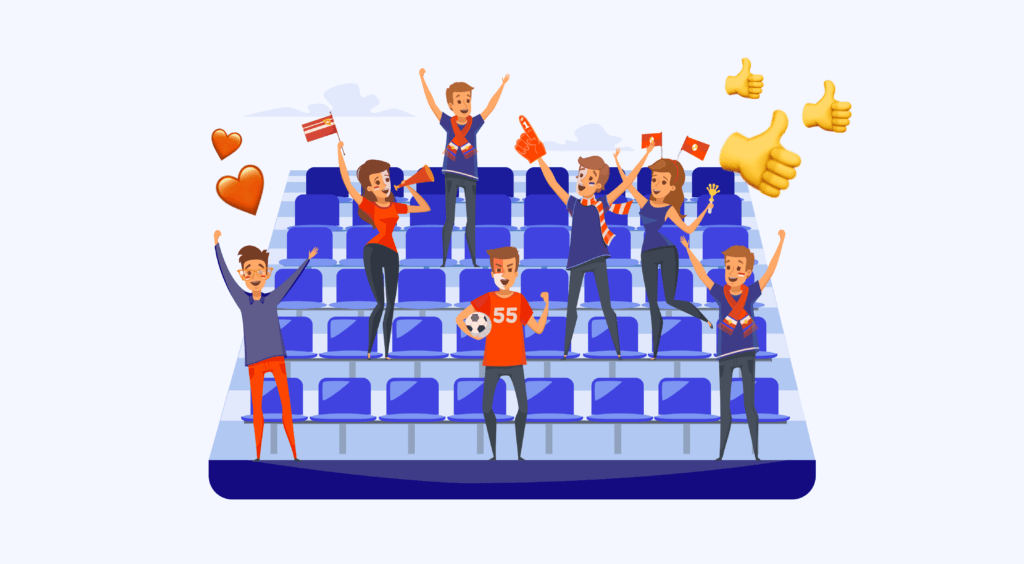
Loyalty is the key to having die-hard fans. The more invested your fans are in your team, the more likely they will be to purchase tickets and merchandise, and come out to fill up stadiums. When you don’t have loyal fans, profits go down; it’s a vicious cycle that can be hard to break.
First and foremost, it’s important to know what makes a fan loyal and how to keep their loyalty high.
It may seem like loyalty is built on pure emotion. But there are actually a number of different factors that keep fans coming back for more. Naturally, the team’s performance is important. If the team starts losing game after game, it will affect the engagement level of fans. Even though they likely still are loyal, it will be substantially harder to monetize on that loyalty. Being able to watch home games in person is also an important way of keeping people invested in their team.
Not only is loyalty important for the sake of building a strong fan base and community. Let’s look a little closer at why loyalty is important for sports clubs.
Before we dive right in...
Subscribe to our blog today to ensure that you never miss valuable posts such as this one. We are passionate about helping sports organizations deliver a world-class fan experience, because better fan experience means better business. So why not use this opportunity to the fullest?

Loyalty drives revenue
Loyal fans are likely to spend more money on their favorite team, whether it be buying tickets, merchandise or being a premium member. The more loyal fans you have, the more likely you are to increase revenue. Not only because they are more passionate, but also because the relationship is likely to last longer. On top of that, the emotional connection between a fan and their team also impacts their lifetime value. Research has shown as high as 306% higher lifetime value because of emotional connection. Loyalizing your fans is therefore not only community-building, but an essential business strategy.
Fans are no longer committed to only one team

Loyalty is no longer completely black or white. This is why the strategies to loyalize your fan base are more important than ever. Research by COPA90 shows that younger demographics are not committing 100% to only one team. In fact, 46% of 16-24 year old fans in the UK support a second team, and 27% of those support a third team or more. Many sports clubs are now facing the challenge of keeping younger fans engaged. Moreover, the same COPA90 report states that 57% of sports leaders found the shift in behavior of younger fans as the “top threat faced by the industry”.

Explore our demo to see how this looks in action
Start now >>
Increased competition for your fans
Sports clubs need to constantly evaluate their strategies to loyalize their fans and keep loyal fans loyal. Especially since sports clubs can have loyal fans that don’t necessarily have a geographical connection to the team. Teams with international fan bases know that loyalty among fans isn’t necessarily only the fans that have the best accessibility to the team. A fan who lives in another country can be much more loyal than one that visits the stadium once a year just because they live close. Then it’s a matter of keeping fans engaged in other ways than only maintaining the going-to-matches relationship. There are many facets of the fan-club relationship that clubs can use to keep fans engaged, absolutely crucial to keep fans loyal.
Here are 7 ways all teams use to maintain loyal fans, from offering freebies on game days, to making sure social media channels are used in optimized ways.
Are you ready? Let’s dive in.

Freebies on Game Day
Freebies are a tried and true marketing strategy to get fans coming back. At sports games, concessions stands offer a variety of free snacks that fans have to pay for if they don’t have their loyalty card. Fans can get a free popcorn, hot dog, or ice cream cone if they present their loyalty card. This is a great incentive for fans to come back and keep their loyalty card with them. Modern stadiums with cashless solutions even offer loyalty as a form of payment, where fans can use their loyalty cards to pay.

Pregame Fan Festivities

One way to bring in loyal fans is by making sure there is pregame fan festivities. This could be anything from a family friendly tailgating area, to a fan and player meet and greet. This is a great way for you to get your fans excited about the game and create some excitement before the game even starts. It also could allow you to generate some extra revenue by charging admission into that area, while still giving the fans an opportunity to interact with each other and their favorite players. Even after the game, loyal fans might want to stick around and listen to post-match press conferences and continue to celebrate if their team won. In this sense, the potential for clubs to personalize their offer stretches beyond the actual match. This is also why stadium entrance data is key. It allows clubs to understand when people arrive, how much they spend and what they do. In order to find the fans on the cusp of becoming loyal fans, you need to understand who your most loyal fans are.

Parking Lots
Another thing that some teams do is offer pre-paid parking. For example, if you buy your season tickets in advance, you can get free parking for the entire season. If you want to drive downtown and see your team play on game day, you can purchase a $10 pass for three hours worth of on-street parking around the stadium before kickoff. This way, if drivers want to spend an hour or more at the game before they head home after work, they know they will be able to find something immediately next door or across the street from them when they leave.

Getting to know your fans
One essential way to keep your fans loyal is to understand their preferences, needs and behaviors. Ultimately, a fan is more likely to become loyal if they feel valued by the team. To keep engaging your fans across different channels is crucial to keep loyalty as well as engagement high, especially in the period between seasons.
As the world of social media continuously expands, there are new opportunities for clubs to build relationships and loyalize their fan base to discover. For instance clubs can use multi-tier membership levels to distinguish the most loyals fans from casual fans. This would make loyal fans feel appreciated and incentivized to continue to be loyal. Other strategies include adding badges to your most loyal fans on your platforms or allowing fans to generate content that you can highlight and repost on social media. By organizing exclusive watch-parties or virtual meet & greets with players for your most loyal fans, there are high rewards for loyal fans to get that ‘hardcore-fan’ status.

Taking Advantage of Technology
Many organizations have taken advantage of technology in order to keep their fans loyal. Today, there are a variety of ways you can use technology to your benefit when it comes to team loyalty.
Loyalty programs also work well with the right promotion. App providers, such as Forza FC and FanMaker, can enable clubs to create virtual fan clubs. Fans get the chance to meet virtually and discuss different topics around the team. While the club is able to gather first-party data on who their most dedicated fans are. By having partnerships with sponsors that have the technological infrastructure, such as banks, clubs can offer cashback rewards systems to their fans.
Another technology that sports clubs can leverage are NFTs. Especially when it comes to loyalty programs. By using blockchain technology to increase fan loyalty, teams can incentivize engagement on a higher level by providing real-time payouts and prizes. Fans can even receive spendable tokens to buy merchandise with. Having this quantifiable engagement is also attractive to sponsors when looking at where to spend their budget.

Social media usage
Well thought out social media strategies are a necessity for sports clubs in order to maintain loyal fans. Although it’s crucial for sports clubs to have a social media presence, the attention span of fans can be limited. Sports clubs have the advantage that most of their fans are, well, fanatics of the sport. This is an advantage because when we’re watching a game live in a stadium, our attention tends to be undivided. But when it comes to social media our attention isn’t as undivided and there are many distractions. That’s why it’s absolutely essential for sports clubs to keep fans constantly engaged and deliver personalized experiences to maintain loyalty.
Using social media is a powerful tool in managing perceptions of your club as well as maintaining relationships with fans. Sports clubs shouldn’t be making the mistake to group all social media channels in one. Rather they should understand the need for each channel and how it can help you. Collect data to understand what kind of content your fans prefer on each platform. Then you can cater to your fans’ different needs across demographics and preferences.
On Twitter the objective could be to highlight important information. Or to provide a platform where fans can have meaningful exchange on specific topics. When it comes to Instagram, the content needs to grab the attention of fans right away with high-quality images and videos. Tiktok, on the other hand, is native to the picky Gen Zs so you need to tailor your content to Gen Z if that’s your target group.

Mascots and halftime shows

Mascots are the symbol of your team. They are the face of your team, and they’re out there doing an incredible job promoting your brand. As a result, it’s important to make sure you have the right mascot for your team. The most successful mascots have a unique appearance mainly targeted at children to get them interested in the game.
Half-time shows are also another popular way to entice fans to stay invested in the game. If you can offer something unique, fans are more likely to come back to see what you have planned next time. For example, if there is a company that provides fireworks displays that people don’t typically see at sporting events, it would be worth using them during halftime so people can enjoy them and remember your game for future reference.
Conclusion
Bringing it all together, being a fan of a team is supposed to be fun, exciting, meaningful and rewarding. When these traits go away, it’s less likely that die-hard fans will purchase tickets and merchandise. Or come out to fill up stadiums. The strategies above can be used in order to increase fans’ lifetime value and expand your loyal fan base.
What kind of strategies do you use?
